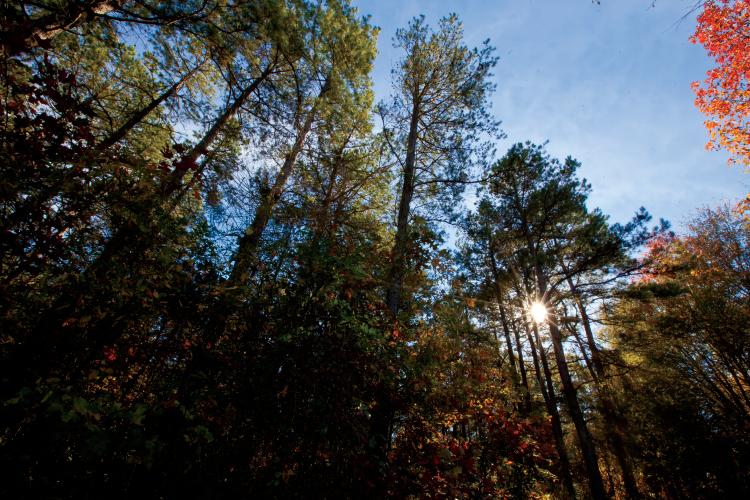Home > Tennessee > Tennessee Farm to Table > Reclaiming Natchez Trace
Reclaiming Natchez Trace
In partnership with: Tennessee Department of Agriculture

It takes photos to prove that Tennessee’s breathtaking Natchez Trace State Forest endured a destructive past.
Nearly a century ago, old farming practices stripped tons of soil from the land’s sandy loam base. Erosion ripped gullies 100 feet long by five stories deep. But today, nearly the entire 37,000 acres of this forest in central-western Tennessee have recovered from their dismal state in the 1930s. In fact, proper management of timber, wildlife and recreational uses has transformed Natchez Trace State Forest into one of the state’s most prized public lands.
“To be in that decimated condition to the point it is today – one of the most valued forest resources in the state of Tennessee – that is a huge conservation success story,” says David Todd, assistant state forester with the Tennessee Department of Agriculture Division of Forestry. “Words don’t describe it. If you look at the photographs from the 1930s to the 50s and 60s to today, it’s unbelievable how that forest recovered. Today, Natchez Trace State Forest is one of the most valued tracts in the state in terms of timber value.”

Natchez Trace State Forest represents one of 15 state forests that encompass more than 168,000 acres in Tennessee. The state also owns more than 50 state parks and a multitude of wildlife management areas and natural areas. Each of these public lands carries distinct management practices tailored to the missions set by law or the respective agencies.
For quick comparison, state park staff manages people and their enjoyment of the land, perhaps through boating and swimming. In contrast, the state’s professional foresters manage the forest resource: timber production, wildlife habitat, aesthetics, forest health, watershed protection and more, says Philip Morrissey, state forest unit leader.
“One way to continue to have a high-quality forest is to manage it actively,” he says.Taking ActionThe federal government acquired Natchez Trace via the Resettlement Act of 1934. The Tennessee Division of Forestry managed the land through a use agreement until 1955 when the federal government deeded the land to the state, and it was placed under the jurisdiction of forestry.Fire control and erosion prevention became the initial emphasis of the Tennessee Division of Forestry, the agency charged with repairing and regenerating the forest. The division put erosion control practices in place. They also planted and established pine trees, which shed needles that deterred erosion.
![Natchez Trace State Forest, Tennessee [INFOGRAPHIC]](https://eadn-wc01-4177395.nxedge.io/wp-content/uploads/2016/03/Screen-Shot-2016-03-10-at-12.36.01-PM.jpg)
As part of its documented management plan, the division today maintains timber inventories, monitors growth and calculates how much timber to harvest annually to remain sustainable. Following harvest, hardwood forests generally regenerate by themselves. Where pine is harvested, forest managers replant genetically improved varieties of pine trees.
All the while, the Division of Forestry intends for these management plans to demonstrate sound forestry practices to Tennessee’s more than 500,000 private landowners who own sizable forested tracts, Todd says.
“We believe it is important for them to understand that they have ways they can manage the land to meet their objectives,” he says. “If they can see the management of our state forests, they can make better decisions on their own land.”
State forest caretakers also oversee trails for horseback riding, biking, hiking and all-terrain vehicle riding. They manage game species in cooperation with the Tennessee Wildlife Resources Agency and allow hunting to control wildlife populations. Their management roles turn cultural too. Natchez Trace State Forest alone contains 24 cemeteries and 62 historic sites.
The Division of Forestry is currently working to establish third-party oversight to certify the sustainable management of its state forests. The division also intends to look at more recreational opportunities in its forests, Todd says.
“These forests are great places to work, but they are also great places to simply be. There are really neat places to visit in these forests, even if you don’t like wildlife. It is a very satisfying resource to the people of Tennessee.”




